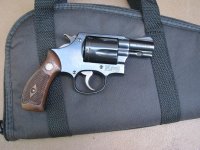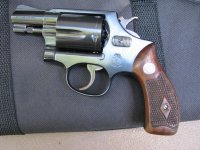I'm not a specialized collector and can't swear that it's a "Baby" Chief, but it is certainly an early one. Note the smaller hammer and the really small flat cylinder release. Collectors like those features.
Personally, I prefer the later larger trigger guard, especially if I need gloves. I also like the larger hammer that soon evolved, and goodness knows, I like the stainless version, Model 60, even better.
But you have just hit the collectors here like a jolt from a whole pot of coffee, and you will probably get offers to buy this gun. Don't sell until you know just what you have and the presumed value.
Hey, if you like it and it shoots well for you, keep it. The only real caveat is that the factory doesn't recommend high velocity ammo (Plus P) until guns were marked with a model number, beginning in 1957-58, depending on the model and how many older frames were still in the production line.
Some dispute this, but I think a metallurgical change in .38 revolvers occurred then. Chic Gaylord, writing in 1960, noted that an S&W exec told him that the heavy barrel version of the basic Model 10 was made of a new and stronger steel. I think this probably applied to all steel frame .38's and to the cylinders of even Airweight models. However ONLY all steel guns were warranted for Plus P until quite recently, when advances in light metals and heat treating got that rating for some lightweight guns. Frequent use of Plus P ammo will eventually result in such wear as accelerated cylinder endshake. This occurs sooner in these small guns than in larger .38's.
It is often accepted that these early steel - framed Chief Specials will safely fire Plus P ammo, and famed gun scribe Elmer Keith even fired 500 rounds in an Airweight one, I believe. But Massad Ayoob stretched the frame on an Airweight Bodyguard, M-38, with just 500 rounds.
I cannot tell you to do something the factory doesn't endorse, but if that gun was mine, I'd fire a box or so of Plus P of my informed choice and thereafter only shoot it rarely to remain familiar with its impact and carry the hot load for defense. You don't need Plus P ammunition to shoot at paper targets, cans, etc.
That noise you hear is the collectors running to head you off from firing it at all. They like to stash such items in their safes and admire them for their historical value. This gun is a definite early step in the evolution of what became the most produced and admired snub-nosed .38 revolver of all time.
Take care of it. It's not only a good gun, it's history on the hoof.
I'm interested in this other gun that you have. I MAY know what it is, but please start a new thread about it with photos. I think you'll be interested in what you'd learn, if it's what it sounds like it may be. You seem to have a knack for acquiring unusual, sought-after firearms.
P.S. Does this gun definitely have a steel frame? It looks like it in the photo. The Airweight frame generally looks more black than blue, by comparison. I'm not sure just when Airweights arrived and some may have had these features. A specialized collector will probably be along soon, with more info.


